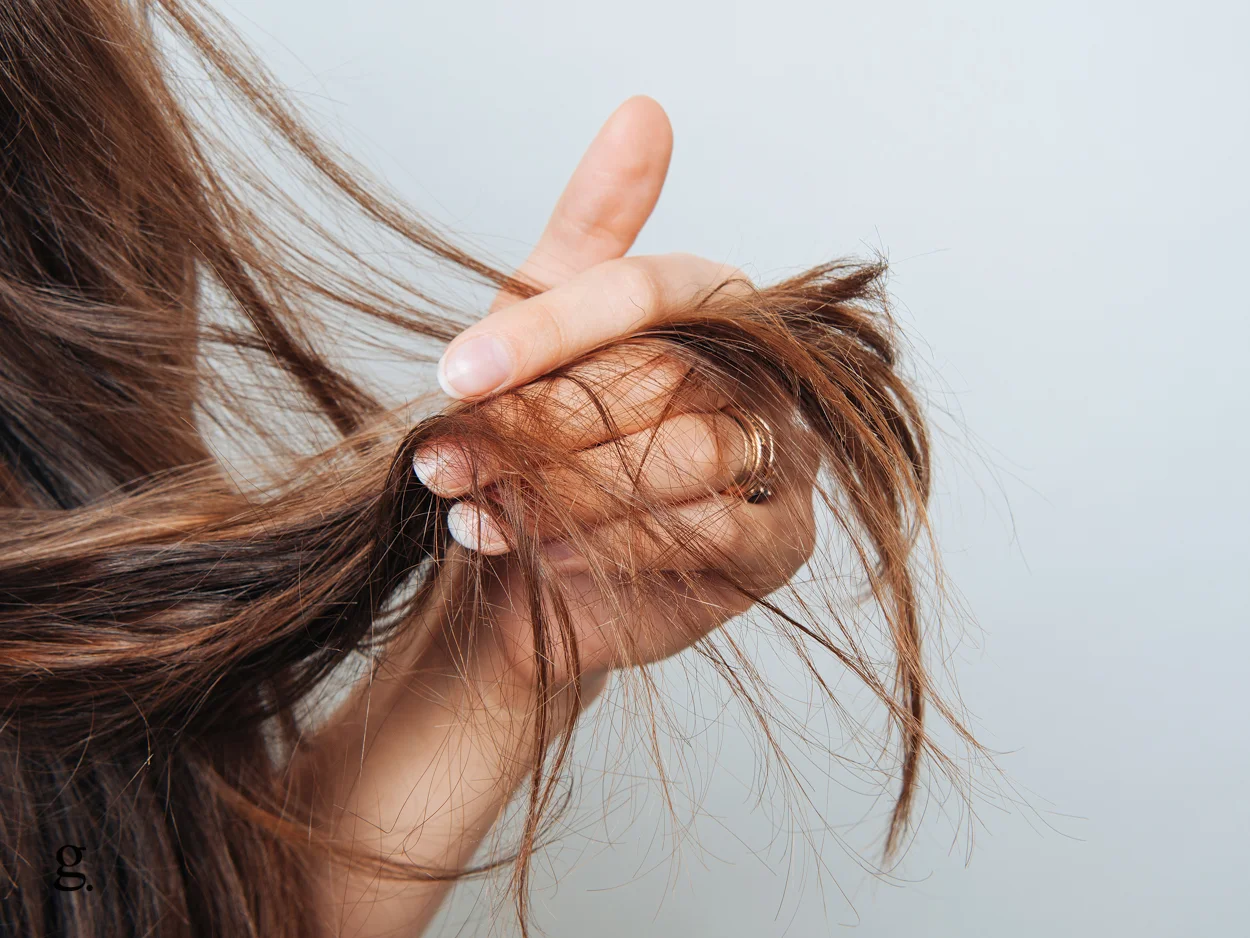Picture this: You wake up one morning, only to discover that your once-luscious locks are looking more like a frizzy, tangled mess. Yikes! No doubt, damaged hair can be a real bummer.
What Is Damaged Hair?
Damaged hair, in a nutshell, is hair that has lost its natural shine, strength, and elasticity. It may appear dull, lifeless, and prone to breakage or split ends. When hair gets damaged, the outer protective layer known as the cuticle gets worn down, exposing the inner layer called the cortex.
This exposure leaves your hair vulnerable to further damage from external factors and everyday styling practices.
The Primary Causes of Hair Damage
Knowing the primary causes of hair damage can help you take preventative measures and make informed decisions about your haircare routine. Let’s dive into some of the most common culprits behind those pesky damaged strands:
1. Heat Styling
Regular use of hot tools like flat irons, curling wands, and blow dryers can really do a number on your hair. High temperatures weaken the hair’s protein structure and strip away your hair’s natural moisture, leaving it parched and brittle.
This lack of moisture can lead to frizz, split ends, and breakage. To minimize heat damage, try to limit your use of these tools, and when you do use them, always apply a heat protectant spray to create a barrier between the heat and your hair.
2. Chemical Treatments
Coloring, perming, and relaxing your hair involves harsh chemicals that alter the hair’s structure to achieve the desired results. These processes can weaken the hair shaft, compromise its integrity, and leave it more susceptible to damage. Over time, this can lead to dull, lifeless locks that are prone to breakage.
To reduce the risk of chemical damage, consider stretching the time between treatments, opting for gentler alternatives, or consulting with a professional hairstylist to ensure your hair is treated properly.
3. Over-washing
Washing your hair too often can strip it of its natural oils, which are essential for maintaining moisture and protecting your hair from damage. When these oils are removed, your hair is left dry, brittle, and more prone to breakage.
To avoid over-washing, determine the washing frequency that works best for your hair type and lifestyle. For example, those with dry or curly hair may only need to wash their hair every few days, while those with oily hair might need to wash more frequently.
4. Rough Handling
Being too aggressive when brushing or detangling your hair can cause unnecessary stress on the strands, leading to breakage and split ends. Instead of ripping through knots and tangles, be gentle and patient when working through them.
Use a wide-tooth comb or a detangling brush designed to glide through your hair without causing damage. Additionally, avoid brushing your hair when it’s wet, as it’s more vulnerable to breakage during this time.
5. Environmental Factors
Sun exposure, wind, and pollution can all contribute to hair damage. The sun’s UV rays can weaken your hair’s protein structure and fade color-treated hair, while wind and pollution can cause tangles and leave your hair coated in dirt and grime.
These elements can dry out your hair and make it more susceptible to breakage. To protect your hair from environmental damage, wear a hat or use hair products with UV protection, and keep your hair covered in windy or polluted conditions.
6. Tight Hairstyles
Consistently wearing tight ponytails, braids, or buns puts tension on your hair, which can result in breakage and hair loss over time.
This constant stress on your hair can also lead to a condition called traction alopecia, where the hair follicles become damaged, and hair growth is inhibited.
To avoid putting too much stress on your strands, switch up your hairstyles regularly, and opt for looser, more relaxed styles that allow your hair to breathe.
Ways To Improve the Appearance of Damaged Hair
If you’re dealing with damaged hair, don’t lose hope! There are several ways to improve its appearance and texture, helping you get closer to the healthy locks of your dreams. Here are some tried-and-true tips to give your hair the TLC it deserves:
Deep Conditioning Treatments
Show your hair some love by indulging in regular deep conditioning treatments that help restore moisture and nourishment to your thirsty strands.
Seek out ingredients like natural oils (such as coconut or argan oil), proteins (like keratin), and vitamins (like vitamin E and biotin) to give your hair the rejuvenating boost it needs. These treatments can work wonders in repairing damage and injecting life back into your locks.
Use a Heat Protectant
When you can’t resist the call of heat styling tools, always make sure to apply a heat protectant beforehand. These products form a protective barrier that shields your hair from the damaging effects of high temperatures. Not only will they help prevent damage, but they can also enhance shine and reduce frizz.
Reduce Chemical Treatments
Be mindful of the frequency of chemical treatments, and explore gentler alternatives like ammonia-free hair dyes, organic hair care products, or embracing your natural hair texture. By reducing your hair’s exposure to harsh chemicals, you’ll be giving it a chance to recover and thrive.
Switch to a Gentle Shampoo
Harsh sulfates found in some shampoos can rob your hair of its natural oils, leaving it parched and prone to damage. Opt for sulfate-free, gentle shampoos that cleanse without causing further harm.
These gentler alternatives will help maintain your hair’s moisture balance and promote overall hair health.
Detangle with Care
Ditch your regular brush in favor of a wide-tooth comb or a brush with flexible bristles designed to glide through tangles without causing breakage.
When detangling, it’s best to do so while your hair is damp, starting from the ends and gradually working your way up. This method helps prevent unnecessary stress on your hair, reducing the risk of damage.
Embrace a Healthy Diet
A well-rounded diet rich in vitamins, minerals, and healthy fats can significantly contribute to stronger, healthier hair. While this doesn’t immediately make damaged hair look better, it’ll certainly make the new hair growing in look better!
Incorporate foods like leafy greens, nuts, seeds, and fatty fish (like salmon) into your meals to provide your hair with the essential nutrients it craves. Remember, the health of your hair starts from within!
Try a Silk Pillowcase
Treat yourself to a silk pillowcase to help reduce friction and breakage while you sleep. Silk pillowcases are gentle on your hair, keeping it smooth and tangle-free throughout the night.
Does Damaged Hair Grow Back Healthy?
The good news is, yes—damaged hair can grow back healthy! As your hair grows from the roots, the new growth is entirely separate from the previously damaged strands. This means that with proper care and attention, you can encourage the growth of strong, healthy hair that’s free from damage.
To support the growth of healthy hair, consider the following tips:
- Maintain a Balanced Diet: Eating a diet rich in proteins, vitamins, and minerals provides your hair with essential nutrients to promote growth and strength. Prioritize foods like eggs, lean meats, legumes, nuts, seeds, and colorful fruits and vegetables.
- Regular Trimming: Regular trims help remove split ends and prevent further damage from traveling up the hair shaft. Aim to get a trim every 6-8 weeks or as needed, depending on your hair type and condition.
- Gentle Styling: Avoid tight hairstyles that cause tension and breakage. Instead, opt for loose, protective styles that allow your hair to rest and grow without strain.
- Scalp Care: A healthy scalp is key to supporting hair growth. Incorporate a gentle scalp massage into your routine to increase blood circulation and stimulate hair follicles.
- Be Patient: Hair growth takes time, so be patient and give your hair the chance to recover from damage. On average, hair grows about half an inch per month, so don’t expect overnight results.
Remember, maintaining healthy hair growth is an ongoing process that requires consistency and dedication.
Can Damaged Hair Be Repaired?
The million-dollar question: Can damaged hair be repaired? Well, the answer is both yes and no. While you can’t entirely reverse the damage done to your hair, you can certainly improve its appearance and manageability with proper care.
Keep in mind that hair is made up of dead cells, so once it’s damaged, it can’t magically heal itself like living tissue. However, by adopting a nourishing haircare routine, you can minimize further damage, restore moisture, and give your hair a healthier appearance.
In some cases, the damage may be too severe, and the only solution could be a significant haircut.
Knowing When You Need To Cut
While it’s natural to want to hold on to every inch of your hair, there comes a time when you need to face the music and opt for a haircut. Knowing when to cut your damaged hair can help prevent further damage and pave the way for healthier locks. Here are some signs that it’s time to schedule a trim or a more drastic cut:
- Persistent Split Ends: If you’re constantly battling split ends, even after regular trims, it’s a sign that you need to cut off more length to get rid of the damaged sections.
- Lack of Shape and Volume: When your hair starts to lose its natural shape and volume, it could be due to excessive damage and breakage. A haircut can help restore life and bounce to your locks.
- Unmanageable Texture: If your hair has become increasingly difficult to style or manage due to dryness, frizz, or tangles, it’s time to consider a cut to remove the most damaged areas.
- Uneven Hair Growth: Damaged hair can sometimes lead to uneven growth patterns. A haircut can help even out your hair length and promote a healthier appearance.
- Lackluster Appearance: When your hair loses its shine and vibrancy, despite your best efforts to nourish and moisturize it, a haircut may be necessary to revive its natural beauty.
Remember that cutting your hair doesn’t mean giving up on it; rather, it’s a chance to start fresh with healthier, stronger strands.
Conclusion
Dealing with damaged hair can be frustrating, but understanding the primary causes and implementing a hair care routine tailored to your needs can make all the difference. By taking steps to minimize heat styling, reduce chemical treatments, avoid over-washing, handle your hair gently, protect it from environmental factors, and choose looser hairstyles, you’ll be on the path to healthier, stronger locks.
Remember, it’s essential to be patient and consistent in your hair care journey, as repairing and nurturing damaged hair takes time. With dedication and proper care, you can gradually improve the appearance and texture of your hair, allowing you to flaunt your gorgeous, healthy tresses with confidence.

